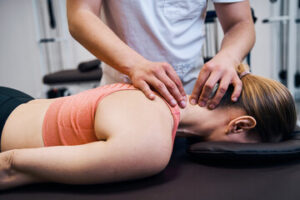A sports massage is a particular type of bodywork that focuses on the muscles used in vigorous activity. It reduces muscle tightness, increases flexibility, and relieves pain.
It also reduces the build-up of lactic acid and other waste products. This improves your performance and prevents injuries. Visit https://www.flowstate918.com/ to learn more.
Even amateur athletes can benefit from a regular sports massage as it helps to keep their bodies healthy and strong. This helps them perform better in their chosen sport.
Whether you’re an elite athlete or the average gym-goer, you can benefit from sports massage. The primary reason for this is that it decreases muscle stiffness and discomfort. However, it doesn’t just help relieve post-workout soreness – it reduces stress levels, improves sleep and increases energy throughout the body.
One of the key effects of sports massage is the release of endorphins. These are the ‘feel-good’ chemicals in the brain that counteract pain, helping your muscles relax sooner. It also helps reduce metabolic irritants such as lactic acid.
In addition to reducing mental stress, massage stimulates the lymphatic system, allowing it to drain away waste products more efficiently. This aids the recovery process, reducing the time it takes to return to your normal activity level following exercise or training.
Another key effect of sports massage is improving flexibility. This is achieved by breaking down adhesions within the fascia and muscles, which create restriction in movement and limit the range of motion in specific joints and muscles. In addition, massage enhances the proprioceptors, which are sensory receptors that provide feedback to the brain about the body’s position and movement. This allows for more precise movements and improved balance, flexibility and coordination.
The increased blood flow caused by sports massage also enables more oxygen to reach the muscles, which improves performance. This is particularly beneficial for those who participate in endurance events such as marathons or triathlons where continuous running is required. Research has shown that massage significantly reduced the occurrence of leg cramps in runners, and improved their running times.
A sports massage may also help prevent injury by loosening up tight muscles before exercise. This helps to reduce the risk of muscle strains and sprains that can result from overuse or improper technique during training sessions.
As well as increasing muscle flexibility, sports massage breaks down scar tissue and releases adhesions within the muscle fibres. This allows the muscles to stretch and move more freely, preventing restrictions in movement and inhibited progress during workouts. In addition, it stimulates the proprioceptors, enhancing the awareness of the body and enabling athletes to identify problem areas and take steps to correct them before they become injuries.
Increases Flexibility
A primary goal of sports massage is to reduce muscle stiffness and discomfort. This is most common after a strenuous workout or exercise, but it can also be caused by long hours of sitting, bad posture, and injuries. Sports massage increases the elasticity of muscle and joint tissues which helps to alleviate discomfort and increase flexibility.
Tissue elasticity is the ability of a muscle to stretch to its full length without restriction. The increased elasticity of muscles and joints from a sports massage increases flexibility which decreases the likelihood of injury during training or an event.
In addition to improving a person’s elasticity, a sports massage can break down adhesions in the muscle tissues. Adhesions are formed as a result of the body’s inflammatory healing process and can cause pain and restrict movement. The deep friction techniques of a sports massage can release the bonds between the muscle tissues and allow movement.
Another physiological effect of a sports massage is increased blood flow to the tissue. This improves the nutrient supply to the tissues and promotes healthy tissues and cells. Increased circulation helps regulate blood pressure and enhances the immune system.
Allyson Felix, Lindsey Vonn and Megan Rapinoe are just a few of the athletes that have credited sports massage for helping them recover from injuries and boost their performance. However, research has been inconclusive regarding the positive effects of massage on athletic performance. Some of the studies have been challenged by design flaws, and additional research is needed to support some of the claims.
The hands-on nature of sports massage may help an athlete gain a greater awareness of the needs of their body. This can help them identify problem areas before they develop into serious injuries. Sports massage can also improve an athlete’s mental clarity and focus by reducing stress levels, which leads to better preparation for training and competition. A more focused mindset can lead to improved performances and a lower risk of injury. Ultimately, the benefits of sports massage are numerous and can be used by both professional and recreational athletes.
Relieves Pain
One of the primary benefits of sports massage is pain relief. During exercise muscles undergo stress and micro-tears that lead to inflammation, the build up of metabolic waste (like lactic acid) and muscle soreness. Massage can alleviate this by increasing blood flow to the area, thereby bringing oxygen and nutrients to the muscle tissues while eliminating waste products and speeding up the repair process.
In addition, massage can increase flexibility by elongating muscles and soft tissue structures such as fascia, ligaments and tendons. This can be achieved by techniques like friction, stretching and kneading which work to improve tissue condition, loosen adhesions and release muscle tightness. These effects are particularly pronounced with deep effleurage strokes that are performed in the direction of the heart, which acts to increase venous return, thus improving circulation. This reduces venous stasis and edema by pushing blood from the site of injury back to the heart.
Regular sports massage can also help prevent injuries. This is due to the fact that massage stimulates the parasympathetic nervous system, causing the body to relax and slow down the production of cortisol which can aggravate injured muscles and tissues. Massage also increases the range of motion of tight muscles and helps the muscle fibres and tissues become more resilient against future injury.
Muscle soreness and stiffness is often a result of overworking or undertraining muscles. It can also occur from other factors such as long hours of sitting, bad posture and other health related issues. Regardless of the cause, it can significantly affect quality of life and physical performance.
During a sports massage, the client will experience a wide variety of manipulation techniques including effleurage, friction, kneading, tapotement and wringing. These manipulations will increase the temperature of the tissues and encourage a pumping action on the underling veins and capillaries. This in turn will increase venous return, eliminates stagnant blood, removes metabolic waste and brings oxygen and nutrients to the tissue whilst eliminating toxins.
Another physiological effect of a sports massage is the reduction in triglycerides which are fats that can form blood clots. It also has an important role in regulating blood pressure, improving circulation and promoting the function of the lymphatic system.
Prevents Injuries
While sports massage is used to treat injuries, it also prevents injury by increasing muscle flexibility, improving movement patterns and enhancing proprioception (the body’s awareness of its position in space). It reduces stiffness and aids recovery from exercise and increases range of motion. This allows athletes to train more frequently and achieve higher levels of performance. Injuries can be extremely debilitating, preventing individuals from engaging in physical activity and affecting their quality of life.
Research demonstrates that sports massage significantly reduces delayed onset muscle soreness (DOMS). DOMS is the pain and stiffness felt in muscles two to six hours following intense exercise or training. It is caused by inflammation and the build-up of waste products such as lactic acid. Sports massage stimulates the lymphatic system and removes these waste products, reducing inflammation and eliminating post-exercise soreness.
In addition, a key aspect of sports massage is the breakdown of scar tissue or adhesions. These scar fibres are formed during the inflammatory process following an injury and can restrict joint mobility, limit muscle elasticity and cause discomfort. The deep friction techniques of a sports massage break down these adhesions, allowing tissues to move freely and function as they should.
Athletes who have regular sports massages are more likely to achieve peak performance during competition. This is due to the improved flexibility, reduction in muscle soreness and speed of recovery from workouts or races. In addition, sports massage can help prepare the mind and psychologically prepare the athlete for their event by boosting confidence and enhancing performance.
It is important for the client to communicate with their therapist prior to treatment so they can discuss expectations, areas of concern and any potential problems. This will enable the therapist to tailor the treatment according to individual needs and ensure the best results. In general, the more information that a patient provides the better, as this enables them to relax during the session and allows the therapist to focus their attention on the relevant areas of the body. It is also recommended that clients wear loose, comfortable clothing for the duration of their treatment.
